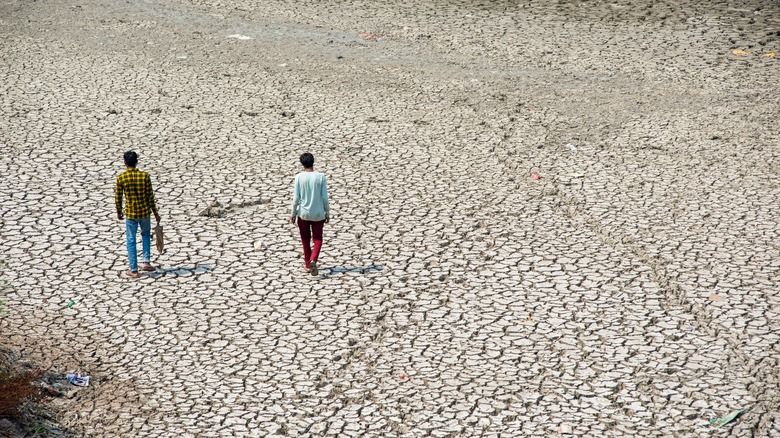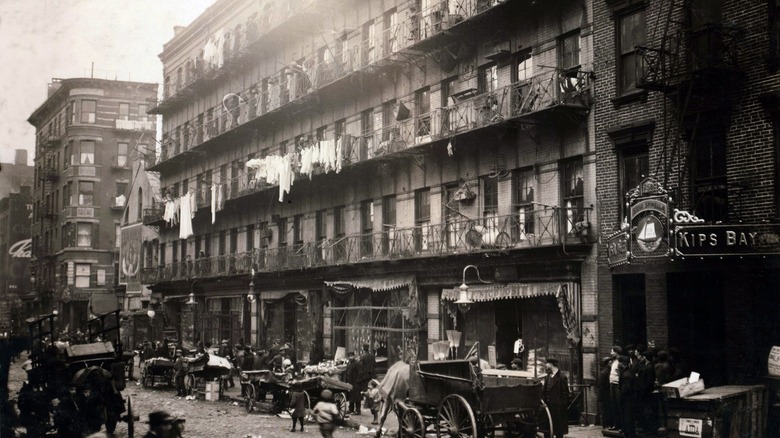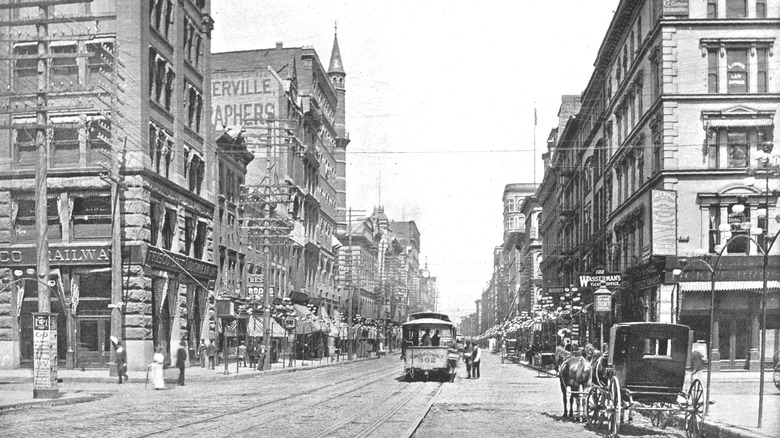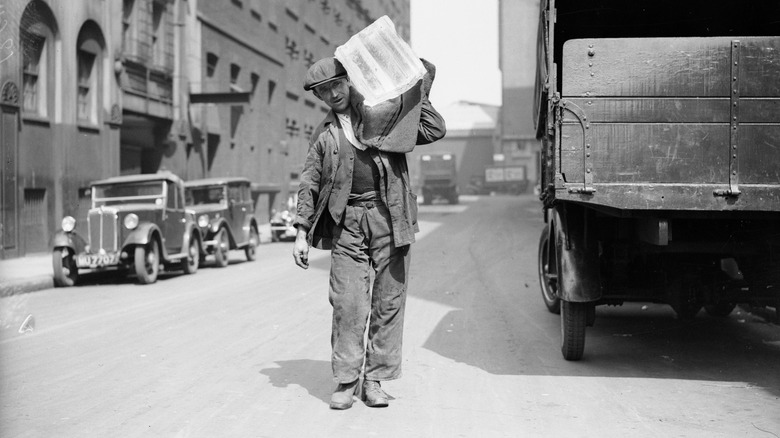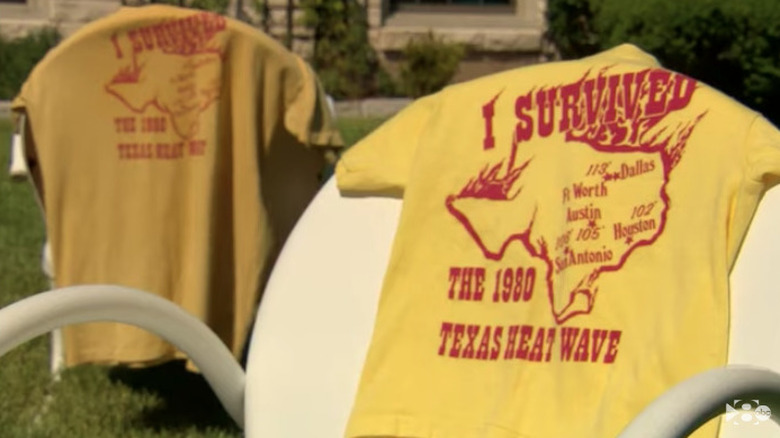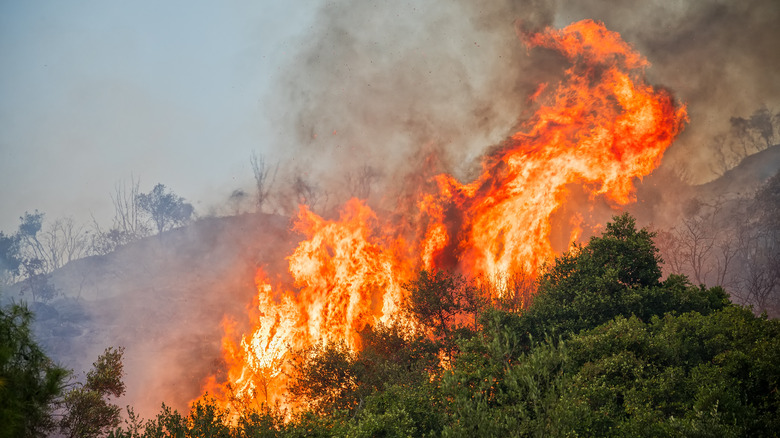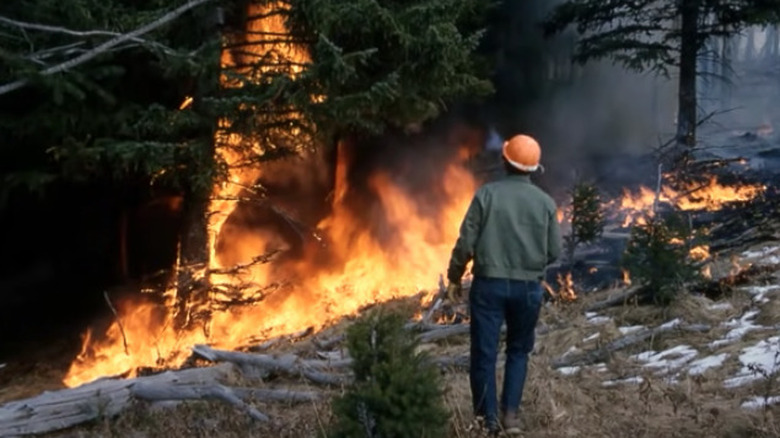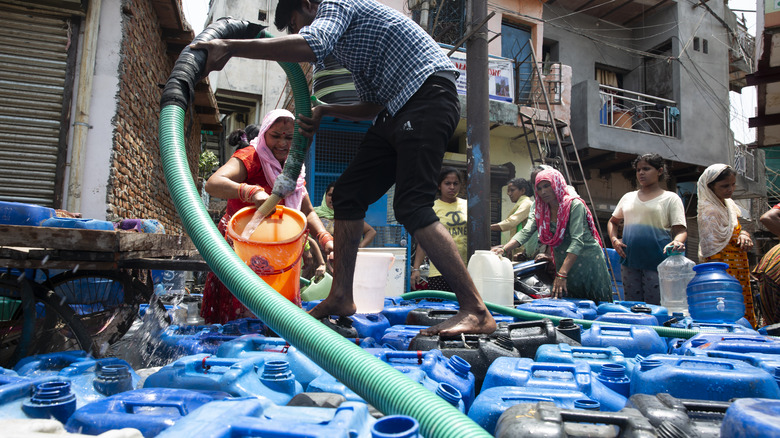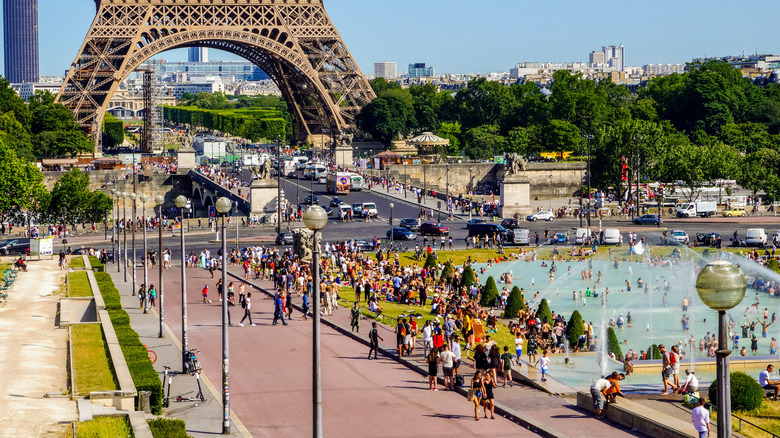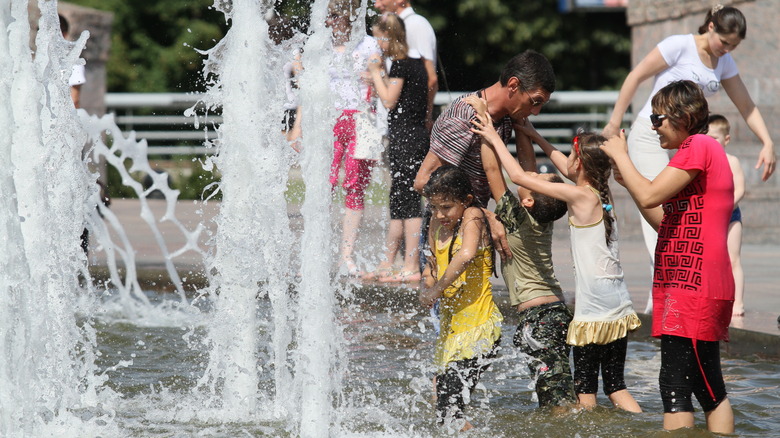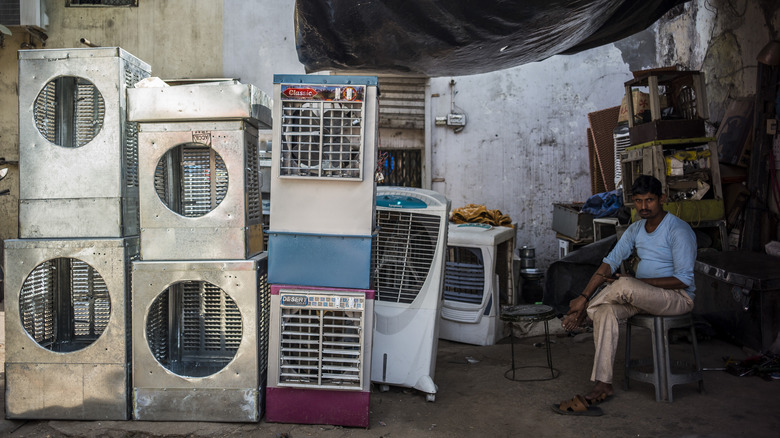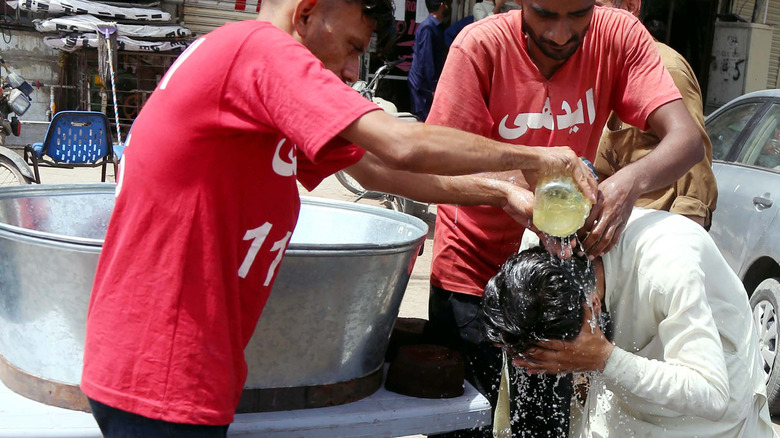The Deadliest Heat Waves In History
The planet feels hotter than ever, and scientists say extreme temperatures are the new normal. In the United States, millions of people have received heat advisories or warnings. Wichita Falls, Texas, reached a staggering 115 degrees on July 20. There haven't been rolling outages, but states are asking people to conserve energy, per NPR. And Europe is faring much worse. On July 19, the United Kingdom experienced their first 104-degree weather ever. The country effectively shut down as the government urged people to stay home, and London's fire brigade received 1,600 calls for help. Most Britons aren't used to that kind of heat, and most homes in the U.K. don't have air conditioning; only 5% do, per NPR. Elsewhere in Europe, heat has caused 2,000 deaths in Spain and Portugal alone, per Axios.
The heat can have far reaching consequences; wildfires have forced people out of their homes, and crops like corn, soybeans, and cotton have trouble growing in temps over 90 degrees, per CBS News. Most frightening is the impact heat can have on public health. People have gone to hospitals after merely mowing their lawns, per CNN. During their drastic heat wave last year, Seattle hospitals ran out of ice and had to shut down operating rooms because they were too hot. But many places across the world have experienced extreme temperatures and have isolated incidents they can refer to. Here's a look at 12 of the most deadly heat waves in history.
1896 Eastern North American heat wave
In August of 1896, a deadly heat wave bombarded the tenement dwellers of New York City, per Times Union. Temperatures reached 90 degrees with 90% humidity every day with no wind and no respite, even at night. Matters were made worse due to the lifestyles of New Yorkers. In the tenements of the Lower East Side, people were crammed in until there were five or six people in a single room. Those who couldn't find a place inside huddled on rooftops, fire escapes, and on the streets outside. And during a time of no air conditioning, the heat encouraged people to sleep outside. Since a ban prevented people from sleeping in public parks, they were forced to sleep in unsafe areas. It was easy for them to fall off of a rooftop or fire escape several stories high, leading to serious injuries or even death. In some instances, people sought refuge on the piers of the East River, only to roll over during sleep and drown. These deaths were in addition to those caused by heat stroke and heat exhaustion. The death toll was an estimated 1,500 people.
The heat wave saw the rise of New York City police commissioner Theodore Roosevelt, who was among the few politicians willing to empathize with the city's poor. He advocated for and oversaw the distribution of free ice and exposed the price-gouging of ice. When he later became the governor of New York, he led reforms against tenement living, per NPR.
1901 Eastern United States heat wave
The heat wave in July 1901 saw a death toll of 9,500. Extreme temperatures affected the eastern part of the United States with every day of the month reaching at least 90 degrees in Bowling Green, Kentucky. 10 days saw a high of at least 102 degrees. Additionally, the city only saw 0.17 inches of rain. New York City alone saw 724 deaths, per Weather.gov. The Sydney Morning Herald reported at the time that 250 horses in New York died in a single week. Buildings were left abandoned as people fled their homes to find refuge in parks, and there were widespread reports of "lunacy" (via Trove).
This was an era before air conditioning and a time when most men wore jackets and hats; that July saw an exception. In St. Louis, a woman, Clara Bosch, died from the stress of the heat. That same day, seven others also died of heat illness. For 15 days, the city experienced temperatures of 100 or higher, including four days of at least 106 degrees. John Boepple, the man whom locals believe invented the hot dog, also died. The only thing people could depend on were buckets of ice, shady areas, and hand fans. All hospitals could treat heat illnesses with were ice baths, per the St. Louis Post-Dispatch.
The summer of 1936
The summer of 1936 was once the standard for terrible heat waves. The weather extremity was rooted in the conditions set by the Dust Bowl of the early 1930s, and the areas most affected by the heat were the Plains, the Upper Midwest, and the Great Lake states, according to Weather.gov. All-time record high temperatures were set, including 110 degrees in Wisconsin and Iowa on July 13 and 14. In Wisconsin, there were nine days with temperatures of at least 100 degrees. An estimated 5,000 people died as a result. Steele, North Dakota, saw 121 degrees, the hottest temperature ever recorded in the United States, per Washington Post. And this was made all the worse because air-conditioning had already been introduced in American society, but it was not yet prevalent; it was only available in stores and theaters.
The region's extreme temperatures were aided by the Dust Bowl drought. There was no vegetation to quell the heat, and the climate essentially became a desert. Lessons were learned and farming techniques were changed with the aim to preserve soil and minimize drought, according to Weather.gov.
1980 United States heat wave
The 1980 heat wave is among the deadliest in the United States. The casualties directly resulting from the heat is listed at 1,260, but this doesn't include death indirectly resulting from the catastrophe, which could be as high as 10,000. The weather brought severe and extreme drought through the Plains and the southeastern United States. It was the hottest it ever was in Dallas-Fort Worth, Texas, with two days at 113 degrees. It broke a number of records in that area, including the longest number of days with a temperature of at least 100 degrees — at a whopping 42 days — and the hottest month based on average temperature, per the Washington Post. In Alabama, high heat and high humidity became a recipe for disaster. The state saw 120 deaths as 80% of the state reached 100 degrees and one quarter of the state reached 105. Hundreds of thousands of chickens died, along with half of Alabama's corn, per Weather.gov.
The heat wave came during the Cold War, and it was so extreme for even Texas weather that some people theorized that the Soviet Union was pointing a space laser at the state. Instead, the heat wave was actually caused by three high-pressure areas in the atmosphere that stabilized over the region. Single high-pressure areas usually disappear within a few days, but the 1980 summer heat wave remained until August, per Dallas News.
1987 Greece heat wave
July 1987 was a tough month for Greeks. The highest recorded temperature in Athens was 113 degrees while average temperatures ranged from 95 to 101 degrees. An estimated 1,000 people died. The country entered a state of emergency and its first aid center received 6,000 calls a day for help, per The Guardian. Hospitals struggled to keep up, especially since most of them lack air-conditioning, and there were 20 deaths daily at Athen's top hospital. A coroner saw 80 bodies in a single day, a spike from the usual four or five autopsies. The victims were mostly the elderly and people with preexisting health conditions made vulnerable with dehydration. Other hospitals sent people out for ice at fish markets in order to preserve bodies. For those who didn't run out of water, they sat in bathtubs and near electric fans, per the New York Times.
The heat was felt throughout the Mediterranean. 60 people drowned in Turkey as they tried to escape temperatures that reached as high as 122 degrees. This didn't dissuade tourists from coming, however. Greek tourist agencies experienced a late-summer boom from English tourists who wanted hotter weather. But they were in for a rude awakening — two British women were among the death toll. Those who survived had to lay with wet towels in order to catch sleep, per The Guardian.
1988 North American drought
The 1988 heat wave was so destructive that it led to the largest fire in Yellowstone National Park's history. 36% of the park was affected, and 300 animals died, per NPS. The heat wave was felt throughout the country. Air conditioning-related power usage rose to record levels in Chicago and Indianapolis, and record high temperatures were listed in 67 different locations in 23 states. Tucson, Arizona, saw 112 degrees and Sioux Falls, North Dakota, reached 110. In Nebraska, highways began to buckle while one town had to start rationing water. Most of the United States experienced temperatures past the 90s, according to UPI.
The effects of the heat wave were felt long after; it brought about a drought that lasted for years. The drought covered 40% of the country and rainfall from April to June of 1988 had been the lowest of the 20th century. Losses to agriculture are thought to have totaled $44.2 billion — $110.7 billion in 2022 money, per AccuWeather. The disaster was among biblical proportions, and religious midwesterners believed that they were being punished by God. Heat-related deaths are estimated to have been between 5,000 to 10,000 people, per Live Science.
1995 Chicago heat wave
For three days in 1995, sweltering heat invaded the midwest, but no city felt it more keenly than Chicago. With its brick buildings, asphalt parking lots, and tar roofs, Chicago was effective at trapping heat and creating a heat island effect, per Chicago Magazine. Their highest temperature recorded was 106 degrees, but the climate suffered from high dew points, as well. The combination of high temps and humidity created a peak heat index of 124 to 125 degrees, per Weather.gov. On July 13, the heat index rose above 120 degrees for six straight hours. To make matters worse, there was no rain.
The heat wave created a death toll of 739 people in Chicago. The first day of the wave saw 911 operators flooded with 16,727 calls. Emergency rooms and hospitals were over capacity and stopped accepting new patients. Many of the victims were elderly, along with construction workers and other people who worked outside. The city was ill-prepared for the heat and were slow to act, and fire officials didn't call in additional ambulances or paramedics, per Chicago Magazine. It took another deadly heat wave in 1999 that killed 114 people for Chicago to begin specialized training for heat preparedness. They have enacted an extreme heat emergency response plan, which includes six cooling centers and 50 cooling buses and routine oversight of the city's vulnerable residents, per Scientific American.
2002 Indian heat wave
It takes a lot for the people of India to consider something unbearably hot. Specifically, temperatures above 115 degrees. In a single, intense week — from May 9 to May 15, 2002 — 1,030 deaths were reported, per CBC. Even for a country that has regularly experienced extreme heat, that year's heat was something they weren't accustomed to. Mud huts and tin-roofed homes became as hot as furnaces as temperatures in the southern state of Andhra Pradesh, where most of the deaths occurred, reached a record 124 degrees.
Even with all of the fatalities, India avoided the worst of it. They issued heat warnings, provided water to the poor, and encouraged people to stay at home. The heat wave was attributed to desert winds that usually precede the monsoon season, which usher in cooler weather, per the New York Times. As the disaster ended, the Andhra Pradesh government promised to compensate the families of the deceased with 50,000 rupees, per CNN.
2003 European heat wave
In 2003, Europe experienced its fair share of heat. That summer was disastrous; it resulted in the deaths of an estimated 30,000 people. France was among the countries that experienced the worst. For more than a week, the country recorded temperatures around 99 degrees and, at one point, experienced a high of 104 degrees. Their nuclear energy production failed due to high water temperatures and low water levels, just in time for demands for more electricity. There were 14,000 deaths in France alone, per CNN.
The heat wave was attributed to an anticyclone that stabilized over Europe and prevented precipitation, leading to temperatures 20-30% higher than average. Pollutants from cars and factories combined with air stagnation created a deadly concoction. Casualties were blamed on neglect of elderly Europeans and a lack of preparedness for heat crises.
The extreme temperatures caused changes in the environment. The Alpine glaciers shrunk by 10% that summer, and thawing of ice on mountains caused rock slides. This was in addition to forest fires and weakened crop production, per Britannica.
Russia's 2010 heat wave
Russia's heat wave during the summer of 2010 was so catastrophic that it holds the Guinness World Record for "deadliest heat wave." The death toll was an estimated 56,000 people. People died due to heat exhaustion, the drought, and forest fires, but thousands of people also died because of heat stroke as they took to the water to escape the heat. The highest temperature of that summer came on July 11 at 111.2 degrees, recorded in the southern republic of Kalmykia (via Guinness World Record).
Although it was the most extreme weather event in Russia's recorded history, scientists ruled out climate change when determining the cause. Instead, it was due to atmospheric blocking, which shielded the country from cool air and precipitation as high atmospheric pressure towered above, per Reuters. There was public frustration over the Kremlin's handling of the crisis. People suspected that the government was trying to downplay the weather and instructed doctors from diagnosing heat stroke as a cause of death. Russian media reported that doctors were told to give diagnoses that sounded less alarming, per BBC news.
2015 Indian heat wave
India was scorched again in 2015, and the province of Andhra Pradesh bore the brunt of it as 1,719 of its residents died. The death toll in all of India numbered 2,330. The same week that cities recorded highs of 118 degrees, roads began to melt in Delhi. The government said heat-related deaths could be avoided by remaining in cool areas, wearing light colors, and staying out of the sun from 11 a.m. to 4 p.m. It was during these hours that taxi drivers opted not to work after two drivers died of heat stroke, per Climate.gov. Many of the victims were poor and homeless. Men slept on sidewalks and concrete stroads, and construction workers slept on top of steel pipes. Water stalls opened, providing free water to passersby, according to CNN.
The heat wave began in May, exposing much of the country to temperatures above 110 degrees. The cause of the extreme heat was similar to that of the heat wave in 2002; pre-monsoon northwesterly winds acted unusually and brought in hot air from the desert areas to the northwest of India, in Pakistan, per Climate.gov.
2015 Pakistan heat wave
Like its neighbor, in 2015, Pakistan endured a sweltering heat wave, except it didn't receive the relief of monsoon rains as soon as India. An estimated 1,100 people died because of the heat wave, per Britannica. The country experienced various power outages, preventing morgues, which were filled to capacity, from properly preserving bodies. Despite the country's best efforts — relief centers handing out water and salt tablets — people flooded hospitals with heat-related emergencies. Some of the patients brought had collapsed on the streets. And the hospitals saw power outages, too, leaving their patients to become sick.
On one day, temperatures reached 112.6 degrees, the highest Pakistan experienced in 15 years. Karachi, its largest city of 22 million people, saw hours-long blackouts. People fought over burial plots as the city began running out of space to bury the dead. The holiday of Ramadan added confusion to the mix, since it requires a fasting period from dawn to dusk. And given Pakistan is predominately Muslim, many intended to adhere to the restriction, per CNN. One cleric, however, issued a fatwa, allowing Muslims to break the fast if their life was in danger, and that diagnosis had to be provided by a doctor, per NBC News.
